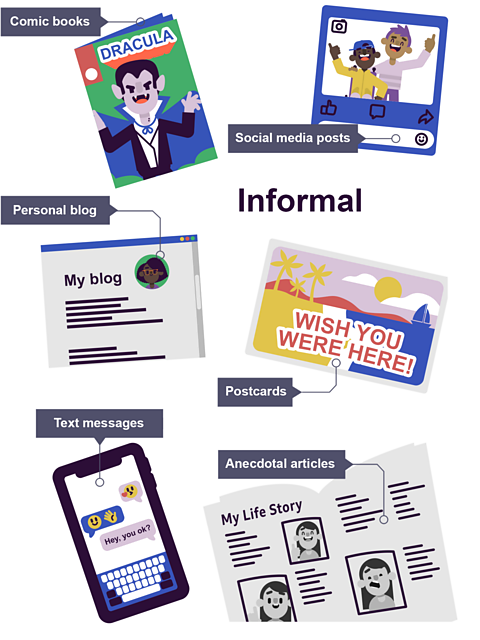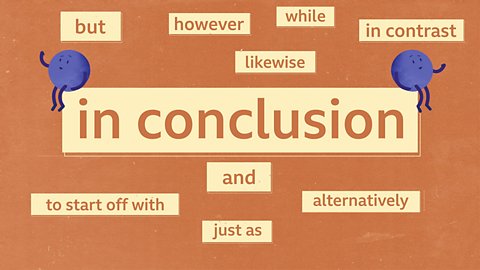What do you know?
What are the correct conventions to use to write a letter to the Queen?
To write a formal letter to the Queen, the convention is to open with ‘Madam’ and close the letter with ‘I have the honour to be, Madam, Your Majesty’s humble and obedient servant’.
Introduction to formal v informal writing
Choosing a writing voice and toneThe writer or narrator’s voice that expresses a feeling or attitude. often depends on how formal or informal the writing is.
Key learning points
- What formal and informal writing means.
- When each form is appropriate.
- The impacts of formal and informal writing on readers and listeners.
- The conventionsSimilar to rules, the way in which a text is usually written. of standard English.
What formal writing is and when to use it
Formal writing can be identified by its serious, unemotional and impersonal tone.
The language is complex, using sophisticated vocabulary that has fewer contractionsShortened versions of phrases such as ‘won’t’ for ‘will not’, ‘innit’ for ‘isn’t it’ and ‘I ain’t’ for ‘I am not’., for example, always using ‘will not’ rather than ‘won’t’.
Formal writing, often, uses more jargonSpecial words or phrases used by a profession or group that are difficult for others to understand., including technical or specialist words.
Formal writing often avoids using ‘I or ‘you’. For example, ‘The answers are believed to be correct’ is more formal than writing ‘I believe the answers are correct’. It creates more distance between the reader and writer which makes it seem more factual.
The spelling, punctuation and grammar follows standard rules or conventions.
Often, formal writing is used to give information but it can also be chosen to impress, persuadeConvince someone of something using reason or argument. or show respect, for example, when writing to an important person.
Examples of formal writing include:
- Essays
- Textbooks
- Official letters
- Contracts
- Newspapers
- Instruction manuals

What is informal writing?
Informal writing is different to formal writing as it is more reflective of a person’s speaking voice and personality.
Informal language is more casual and spontaneous than formal writing. It can also show the relationship between the writer and reader. For example, a writer is likely to write informally to close friends and family or when their audience is their own peer group.
Informal writing can use sentences, paragraphs, vocabulary, and punctuation much more freely for dramatic effect or simply to sound relaxed, chatty and friendly.
There is no expectation to be balanced or objective.
Contractions (can’t, isn’t), abbreviatonA shortened term of a word or phrase, for example FYI stands for 'for your information.' (FYI, LOL), slang (kids, cuppa) as well as incomplete sentences (Hey! Alright?) are commonly used.
Examples of informal writing include:
- Comic books
- Social media posts
- Personal blogs
- Postcards
- Text messages
- Anecdotal articles

Contexts for different levels of formality
The decision whether to use formal or informal writing often depends on the context or situation that you are in.
There are levels of formality and informality:
- You would need to be extremely formal with the King, addressing him as ‘Your Majesty’ if you met him, whereas, if you were writing a letter to apply for a job you would still be formal but not to the same level.
- You might write informally to your Gran but much more informally to your best mate.
If it was a serious or sad situation you may also choose to be more formal. For example, you might write to express your condolences rather than send a hug by text to the family of someone who has passed away.
A formal letter or email would have a standard greeting ‘Dear Ms. White’ and sign-off ‘Yours sincerely, Nathan Reilly’ whereas an informal letter or email might use a first name ‘Dear Gemma’ and end ‘Love Nate’.
It's helpful to know when and how to switch between the different levels of formality in writing. Some of it is about knowing rules and conventions so that you don’t offend your reader or make it easy for them to ignore or underestimate you. However, you are likely to always be more informal with people you know well, like friends and family, or those you are in a similar age group with.

Which tone is the most appropriate for a presentation at a school assembly about the benefits of eating fruit?
A. Evidence shows that there are important health benefits to eating five portions of fruit and vegetables each day. What does this mean for our school dinners? What can we do here and now to help to improve our diets?
B. Apparently it's super important to nosh on at least five portions of fruit and veg each day, so that we can be fit. That means you and me, fam, need to get real, real quick.
C. There is significant evidence that eating 80g of five different types of fruit and vegetables can reduce the risks of many health problems. This has ramifications for all of us. It would be reprehensible, immoral and counter-productive for us to ignore this clearly well documented research and we should heed the advice to support our scholastic community.
Answer:
Option A is the most appropriate. It is formal but engages its audience with straightforward language. Option B switches too dramatically to informality which might provoke laughter rather than listening. Option C uses very complex formal vocabulary which makes it hard to follow.
Intended audience and expectations
Formal and informal language serve different purposes. It’s important to know when formal or informal writing is expected as it helps a writer to connect with the reader or listener.
- Your best friend would be surprised to receive a text saying: ‘Good morning, Madam’. Equally, the head teacher would probably not appreciate being greeted with ‘Yo, Big G!’
It can be helpful to think about your intended audience. The topic could be exactly the same but the way you communicate might be different.
Some questions to consider:
- Are you writing to someone you know well or someone you have never met? If you know them well, you can probably be more relaxed and less formal.
- Is the person you are writing to older or younger than you? If they are much younger than you, using complicated, formal language is not going to help them to understand you.
- Are you writing to someone important who needs to take you seriously? If you want to be taken seriously, emojis, jokes, slang and lots of exclamation marks will not reassure the reader that you are mature, intelligent and someone to be listened to. They might even think you are being rude.

Here is an example of an invitation to a party. Rank these invitations from most formal as 1 and least formal at 3.
Hey Lukas. Do you wanna come to a party at mine this weekend? Let me know asap, Cody.
To Georgia Moore. You are invited to Cody’s birthday party at 7 pm on Saturday at 1 Wood Drive. RSVP to Seema (Cody’s mum) on 123 1234.
Miss Knott, Your presence is requested in honour of Cody’s 13th birthday at 1 Wood Drive on Saturday 20th June at seven o’clock in the evening. Carriages at midnight. Dress to impress. RSVP to Mr. and Mrs. Brown 123 1234.
Answer:You should have ranked 3, 2, 1.
3 uses the most formal language with more information and no shortened words or phrases. 1 uses the least formal language and is very casual using ‘do you wanna’ instead of ‘do you want to’.
Conventions of Standard English
Standard EnglishA form of speech or writing that is grammatically correct and is widely understood. follows all the rules of grammar, punctuation and spelling that formal writing uses.
It is used every day to be polite when dealing with people we do not have a personal relationship with such as the public, teachers, nurses, doctors, police officers, shop workers and everyone that is not a friend or family member.
Standard English has been standardised so that the widest group of people can understand it. Both standard English and formal writing do not use dialectThe words and grammar that a group of people use. The group are usually from a specific area or place. (regional spellings and words) and slang terms.
Find out more about slang here.
Unlike formal writing, Standard English can use contractions, abbreviations, simple language and short sentences – it just has to be grammatically correct.
Test your knowledge
Play Bitesize secondary games. gamePlay Bitesize secondary games
Have fun playing science, maths, history, geography and language games.

More on Non-fiction writing
Find out more by working through a topic
- count8 of 10

- count9 of 10

- count10 of 10

- count1 of 10
